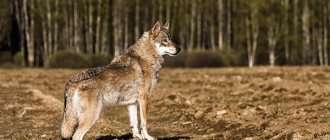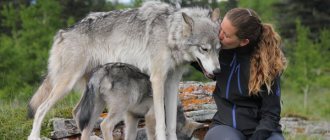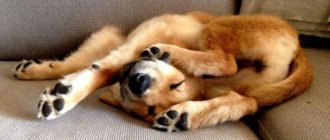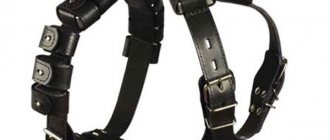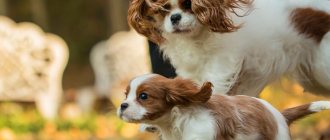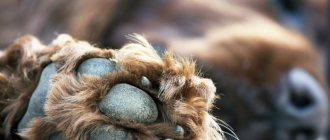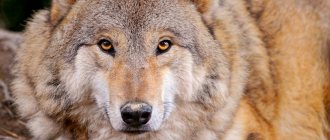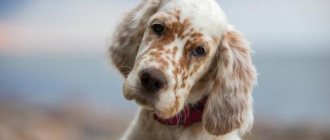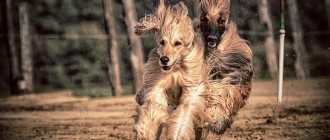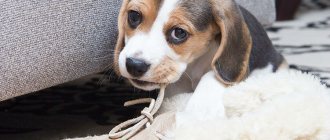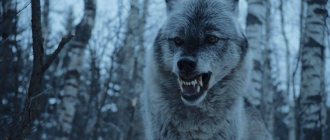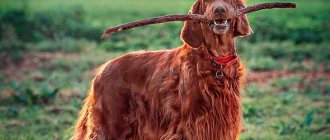For a long time, humans have been attracted to the independence and strength of wolves.
Wolfdog - These beautiful and graceful animals fascinated people. And everyone probably knows about the impression a wolf howl creates. And of course, when mankind began to have four-legged canine friends, many owners wanted them to be like their mighty ancestor. This is how many breeds appeared that look very similar to wolves. There are both very ancient breeds and those that appeared relatively recently. So, the top 10 dog breeds that look like a wolf.
Wolfdogs
It is not difficult to guess from the name that these are direct descendants of wolves. This is a fairly young breed of dog that was bred in the Soviet Union. Outwardly very similar to wolves, wolf-dogs are nevertheless not afraid of humans and are capable of learning. They were bred for military purposes, as service dogs of the armed forces, and this is where their qualities were most useful. They sense the target better and have sharper hearing. And like any service dogs, they require special treatment. The owner of this dog must be a leader; this breed is not suitable for a beginner.
East Siberian
Currently, the East Siberian Laika is considered not yet fully formed and is more likely to represent a breed group than a breed. It is believed that the ancestors of these dogs were aboriginal hunting huskies of four breeds:
- Amur;
- Yakut;
- Tunguska;
- Pribaikalskie.
The breed is approved by FCI standard number 305.
The exterior of this dog is somewhat different from what a Western-type husky looks like. Firstly, this variety has larger sizes (height for males is 57-64 cm, for females - 53-60). Secondly, East Siberian huskies are characterized by a more powerful build and a large skull. There are also differences in color. The following types are typical for the East Siberian Laika:
- karamisty (black with red tan);
- pure black;
- black and white;
- zonal;
- white;
- brown;
- pale yellow;
- ginger;
- spotted.
East Siberian huskies are considered the tallest among their breed group (maximum height at the withers is 65 cm). However, compared to other varieties, the development of puppies is much slower.
The East Siberian Laika is suitable for hunting:
- deer;
- wild boar;
- bear;
- squirrel;
- fur animals;
- moose
At a young age, these dogs are interested in small animals. A fully formed adult husky moves on to larger game. Due to its size and strong bones, this breed is best suited for bear hunting.
Utonogan
This dog looks like a wolf that hasn't been shorn for a long time. The fluffier coat makes this breed adaptable to living in harsh environments. This cross between a German Shepherd, an Alaskan Malamute and a Siberian Husky makes an excellent companion dog for those looking to adopt a pet wolf. Possessing a cheerful and lively disposition, the utonogan will become a favorite of the whole family. The only thing you have to keep an eye on is that the utonogan inherited its appetite from its gray ancestor, so the diet needs to be balanced so that there are no problems with excess weight in the future.
Interesting Facts
Professor S.A. Back in 1929, Gruner spoke in his writings about the crossbreeding of wolf blood into sled-like huskies by some peoples of Siberia and residents of Kamchatka.
The resulting hybrid of a husky and a wolf was highly valued for its higher levels of endurance, the ability to go without food for a long time, and its extraordinary agility.
To know exactly what a husky-shepherd hybrid will look like and what character it will be endowed with, it is advisable to select a puppy that is at least 6 months old.
A big risk is associated with the purchase of two-month-old kittens. At this age, it is impossible to predict what an adult dog will look like.
The Laika is not intended for city living, but a cross between a Laika and a Shepherd can adapt to life in an apartment without any problems.
Since the usual bustle, inherent in megacities, is an acceptable habitat for shepherd dogs.
When crossing a husky and a husky, the result is an almost ideal dog, combining the qualities of a good watchman and a loyal friend. By the way, the excessive activity of the husky can be slightly dampened by the husky genes.
A mixed-breed dog is always a bit of a mystery; it is difficult to predict how such a pet will behave.
In any case, you should purchase mixed huskies only from experienced professional breeders. This will allow you to warn yourself against buying a failed experiment or a “pig in a poke.”
Breeding mixed-breed huskies through absorption crossing will improve some qualities of purebreds.
Breeding good hybrids is a matter for professionals, involving long-term responsible work.
Northern Inuit
This large and beautiful dog is known to many from the series “Game of Thrones,” where Inuit were used to play the role of animals from the coat of arms of the Stark family, the direwolves. It is a descendant of the German Shepherd and Siberian Husky. Most often, this breed is used as a working breed, as it has a calm disposition and excellent endurance. Outwardly, they resemble a large white wolf with a calm and gentle character. The breed is still very young; their breeding began in the 80s of the last century in Canada. Selection was then continued in Great Britain.
Small
The Flat (straight-coated retriever) is very similar to the Labrador. The size of such dogs can be called average: their height at the withers does not exceed 60 cm. Flat-haired retrievers were known in European countries even before the appearance of Labradors. These dogs were often owned by hunters. At the beginning of the 20th century, Flats were slightly replaced by Labradors and Golden Retrievers, however, such dogs again began to gain great popularity, because they are light and compact.
Flat-coated retrievers are less prone to joint pathologies than Labradors. They are not very aggressive, but they have a remarkable guardian instinct. Mini-copies of Labradors were also bred: they appeared as a result of inbreeding and deliberate experimentation by breeders.
Tamaskan dog
This is a large dog, very reminiscent of a wolf. She does not have direct wolf roots, being a descendant of the northern Inuit, Alaskan Malamute and Siberian Husky. This breed was bred in Finland; breeders set themselves the goal of breeding a domestic dog that looked like a wolf. As a result, they got a big, beautiful and very friendly dog, which is really not at all suitable for keeping in an apartment. This is a fairly hardy breed, suitable for work.
They are gentle, calm, love children, very smart and easy to train. These dogs love to live in a pack, so it is best to get several Tamaskans at once, this will make them much more comfortable. They will feel best in a large yard where they can roam freely. This breed is not suitable for residents of mild and warm climates.
South African Boerboel
Classic guard dog. She comes from Africa. It has excellent endurance and excellent health. It is worth noting that the South African Boerboel has many opponents. The reason is that these dogs often attacked people, the consequences of their attack were severe. Yes, this is a serious animal, bred specifically to protect people and territory, however, with the right approach to its upbringing, it will not grow up to be aggressive.
Advice! When training a Boerboel, you can use harnesses for large breed dogs. If he starts to resist following you, they need to be tightened further. The height at the withers of the animal is 65 cm, it weighs about 85 kg. The dog has a large, wide muzzle. The color of the short coat is fawn, less often brindle.
To turn a puppy of this breed into a well-mannered, balanced dog, he needs to be regularly monitored in order to correct his behavior. If he barks at every person who comes, there will be a need for a light punishment. You cannot hit a Boerboel, like any other dog, as this will make him angry and overly suspicious. This is an intelligent breed that responds to the emotions of its owner.
Siberian Husky
This is a direct descendant of the wolf. Considered to be a native sled dog. These fidgets require constant exercise and are perfect for a person with an active lifestyle that they enthusiastically share. She will be a wonderful companion for them. Quite willful, they can run away on their own for a walk. They can bark, but prefer to howl.
They are considered good family dogs and are well suited for families with children, but their needs for significant physical activity must be taken into account.
Recognized breeds similar to wolves
Alaskan Malamute
Height: 58-64 cm Weight: 24-38 kg IFF classification: group 5, section 1, No. 243
This is a large sled dog that was bred by the Eskimos to work in the extreme conditions of the north - an aboriginal factory breed. The Malamute is indeed very similar to a wolf and is one of the oldest breeds.
He needs constant physical activity and long walks. Malamutes are very attached to the family and love children. But in training a dog requires a “steady hand.” It is easy to care for such a pet: Alaskans are clean and eat little. Read more about the Alaskan Malamute here.
Siberian Husky
Height: 50-60 cm Weight: 15-28 kg IFF classification: group 5, section 1, No. 270
This is a native sled dog of the Russian Far East. It was obtained from animals that belonged to the tribes of the peoples of Anadyr, Kolyma, and Kamchatka. At the beginning of the 20th century, during the “gold rush”, huskies were brought to the USA, where they were registered by dog handlers.
Husky is an intelligent, hardy breed with a strong hunting instinct. However, they are not suitable for hunting and protection. Husky will be an excellent companion for people with an active lifestyle, because they need constant work of muscles and mind. If you live in the middle zone or in the north of Russia, dream of devoting a lot of time to your pet and love luge sports - then this breed is for you!
Wolfdog of Saarloos
Height: 60-75 cm Weight: 35-48 kg IFF classification: group 1, section 1, No. 311
In 1925, the Dutch breeder Lander Sarloos After Sarlos's death, his wife and daughter continued the breeding work and in 1981 the Dutch Kennel Club recognized the new breed.
The Saarloos Wolfhond looks like a wolf, but is loyal and trainable. In Holland and other countries they are used as guides for the blind and to save people in extreme situations.
These are both independent and very attached animals to their owner.
An interesting feature: Saarloos dogs cannot bark, they only howl like wolves.
Czechoslovakian Wolfdog
Height: 60-65 cm Weight: 20-26 kg IFF classification: group 1, section 1, No. 332
The Czechoslovakian Wolfdog is a relatively new breed - the breed was recognized by the FCI in 1999. The Wolfdog arose as a result of crossing the German Shepherd and the Carpathian wolf. They resemble wolves in everything, even in their inability to bark. But the wolfdog can howl in different ways.
The wolfdog has a strong and independent character, the future owner of the pet must match. Training cannot be called easy, but training is still possible. The main thing is to avoid routine and dilute your activities with fun games.
Italian Wolfdog Lupo Italiano
A wolf-like cross between a German Shepherd and an Apennine wolf. Considered a working breed, it successfully helps people in rescue operations. An excellent watchman and security guard, independent and loyal. The breed has not been recognized by the International Canine Federation, although this breed is common in Italy.
In any case, they are all worthy representatives of their gray ancestor, from whom they took all the best.
Russian-European. Description of representatives
The Russian-European Laika is a dog of medium height (52-58 cm), strong build and lean constitution, agile and lively, with well-developed muscles. She has a wedge-shaped head with a wide skull, the muzzle is shorter than the length of the skull, the transition from the forehead to the muzzle is hardly noticeable, the cheekbones are clearly defined. The eyes are cheerful, oval, with a slight slant, and the ears are triangular and erect. The legs are straight and level, the tail is curled and pressed to the back or thigh. The coat is coarse and thick, long and straight, with a dense soft undercoat. There is a lush collar of wool and scruff on the neck, shoulders and withers. On the hind legs the hair is longer and shaped like pants. Colors include black, piebald, white, red and zonular.
The dog has a very friendly character, is very independent and balanced, it is characterized by agility and playfulness, devotion and loyalty to the owner. It should be washed and bathed only when necessary, since dogs are very clean and tidy.
Tamaskan
Features : physically hardy, tenacious
A wolf-like dog originally from Finland - the Tamaskan - really closely resembles its wild relatives. Bred as working dogs, they have a tenacious nature. Tall and lanky, with a head shape characteristic of wolves, Tamaskans captivate with their stunning yellow eyes.
Smart and agile, Tamaskans cope well with any physical activity. In its absence, they indulge in destructive behavior.
Pomsky
Features : unpredictable, convenient for keeping in a small apartment
The mini-wolf or Pomsky is the product of genetic hybridization between a husky and a Pomeranian. Gentle and playful babies have become an excellent alternative for keeping in a limited area.
Fun fact: Pomskies don't like hugs. During hugs and affection, they try to turn away or look away in the other direction.
However, such hybrids are unpredictable. The chosen puppy may radically change color and become less like a wolf puppy. In addition, you should buy a Pomsky from a trusted breeder. In the hands of unscrupulous people, the resulting hybrids have unpleasant character traits.
Alaskan Klee Kai
Representatives of the breed are distinguished by their miniature size. But in appearance they resemble their wild relatives. The Alaskan Klee Kai is a small domestic wolf with pointed ears, thick, fluffy fur, and expressive eyes. These dogs are active and inquisitive. But in an unfamiliar environment they show isolation and restraint.
Apple does not leave the market in Russia, agreeing to install Russian software
Many lines and two branches: we read the marriage lines under the little finger
“Rasputin” on bass guitar: the Italian’s video in Russia collected 8 million views
Kugsha
Features : hardy, smart
The Kugsha or American Indian Malamute is used for hauling heavy loads and carts. The dog's wolf-like appearance is due to its long, wide muzzle and bushy tail. The long coat of the cougar requires constant care.
Possessing high intelligence and a desire to work, representatives of the breed are highly valued. Their unwavering loyalty makes them a reliable family companion.
Samoyed husky
Features : friendly, sociable
Having been bred in the harsh conditions of Siberia, Samoyed huskies have incredibly warm fur. Dogs were used to track game, hunt, and keep people warm at night. The snow-white Samoyed resembles a majestic white wolf. However, from its cute face it is clear that this is far from a wild animal.
Did you know that in severe frosts, the coat of the Samoyed husky fluffs up additionally to retain body heat?
Smart and ambitious huskies adore people. Having chosen their owner, they are ready for any interaction. When not exercised, Samoyeds will indicate their displeasure by barking, howling or grumbling.
Swedish Vallhund
Traits : energetic, prone to frequent barking
Bred for herding, Vallhunds have great energy and personality. Vallhunds love games and cannot sit idle for long. In case of boredom, the dog will find entertainment for himself, but it is not a fact that people will like it.
It should be remembered that this breed loves to howl, just like its wild ancestor. The Vallhund can howl to notify you of a fly entering your home, the arrival of a postman, or a lost ball.
Belgian Tervuren
Features : anxious, overly active
Intelligent and easy to train, herding dogs native to Belgium have a confident appearance and distinctive coat. Dogs require attention due to separation anxiety. In the human family, such a pet is always with all its paws for any activity.
Did you know that because of their phenomenal speed and obedience, Tervurens were used during World War I and World War II?
What they have in common with wolves is their elongated muzzle and sharp, erect ears. In addition, Tervurens are indispensable for hunting due to their pronounced pursuit instinct.
Devon Rex
In the 60s, a kitten appeared in Britain that was unusual and captivated everyone. This was the result of a gene mutation and mating with the Cornish Rex breed. The appearance of the resulting cats frightens some, but pleasantly impresses others.
The pet is small in size, has huge, widely spaced ears, its muzzle is flat, and its nose is snub-nosed. Devon fur is soft and hypoallergenic. These animals are active - they run, play, jump, and climb to heights.
Thanks to their developed intelligence, Devons are trainable. Since these are small cats, they need to be treated with care.
It is especially important to protect them from drafts. Such cats in the apartment
Health and illness
Artificial selection, which northern hunters have carried out for centuries, has made the husky one of the healthiest breeds. Therefore, there are no diseases characteristic of this breed and it is very resistant to viruses. But given her nature, the likelihood of injury and fractures is quite high.
Regular walks are mandatory, otherwise the dog may become depressed. If the dog does not follow the correct daily diet, or does not lead an active lifestyle, then there is a possibility of developing a number of ailments related to digestion, kidneys, eyes, ears, and joints.
Lifespan
The lifespan of a husky is 14–16 years. However, this period can very easily be shortened with poor nutrition and improper care for the dog.
Akita Inu
Traits : stubborn, willful
The Akita Inu, a dog breed developed in Japan, is also a relative of wolves. A thick fur coat, pointed ears and an elongated face are characteristic features of the breed. Loyal and affectionate with their family, Akitas are wary of strangers.
What makes the breed unique is its unpredictable and sometimes aggressive character. That is why Akitas received the status of a dangerous breed. Without proper upbringing, such a large pet can cause a lot of trouble.
How to choose a puppy
Choosing a Laika puppy yourself is very difficult. It would be right to take the help of experts, hunters, and dog handlers. You need to purchase a puppy from a nursery, where, if you really want to, you can get documents for a purebred puppy and see its parents and their documents. The price for such a puppy will be significantly more expensive than the price for a pet without documents. Therefore, the owner of the dog needs to immediately decide what its purpose will be. If you need it for hunting, security, or just playing with children, then documents for it are completely optional. And if the owner plans to participate in exhibitions or breed dogs, then they cannot do without documents.
Depending on the working qualities of the parents, the minimum cost of a puppy starts from 2000–3000 rubles and can reach up to 40 thousand rubles.
A puppy can be picked up from the kennel when it is one and a half months old. At the same time, he must be playful.
Finnish Lapphund
Features : loving children, gentle and kind
The Finnish Lapphund's love for children knows no bounds. This breed will do anything to make its owners smile and spend time with it. Gentle and kind dogs would rather run away from a threat than fight back.
Hardworking and intelligent, Lapphunds only bark for a specific purpose. Adaptable and curious, the breed is great for novice dog owners.
Groenendael
Features : very smart, good-natured
If the Samoyed husky is a snow-white wolf, then the Groenendael is pitch black. Its lush black coat distinguishes it from its fellow Tervuren. This breed is a sports dog. A muscular body, incredible agility and high intelligence are what make them successful in sports disciplines. Despite his good-natured disposition, Groenendael will rush to protect his human family from danger without hesitation.
Tell us which breeds you have already heard about and which ones are new?
